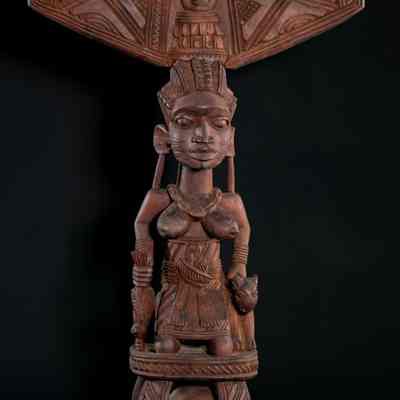Label Type
Cultural/Historical ContextLabel
" Lamidi Olonade Fakeye instructs sculpture at Obafemi Awolowo University, Nigeria. His family has shaped wood for six generations. The name, “Olanade,” translates “the carver has arrived,” fortelling Lamidi’s less-than-surprising artistic destiny. He uses the family name “Fakeye,” given by the King of Ila to his great-grandfather in honor of that man’s renowned sculpture.
However unfair it may seem to his more curious University students, Fakeye passes to only his nephews the traditional technique of the Yoruba people. African woodcarvers generally limit access to cultural niches. Requirements for apprenticeship include: coming from a woodcarver’s family; consulting a diviner (Babalawo) for endorsement; and performing sacrifices at the shrine of the god of iron (Ogun).
Fakeye apprenticed first with his father, then sculptor George Bamidele Arowoogun. The novice spends months painstakingly smoothing over the master’s work, hoping to absorb the style. Eventually he roughs out forms and defines facial features. Upon mastering the art, he develops his own style, resembling the master’s but expanding it. Stylistic changes between Fakeye’s early and late works make sense in light of this training.
In the1960’s, Fakeye’s objects resembled his two instructors’ – symmetrical and frontally positioned. Later, his figures begin to lean forward and gaze to the side. The poise also deviates from tradition, once serene now tender, more expressive. His works take on a quality of expectancy and liveliness. Fakeye credits this nontraditional interest in movement to Western sculpture.
In “Sango Worshipper with Ose,” (aquired by Purdue, 1994) see the element of tenderness: a woman securing her child. Upon her head the winged headdress signifies the god of thunder. She restrains ram and cock, intended for sacrifice. Fakeye carved from oroo, a modern African mahogany not traditionally used. Its satiny finish comes from apprentice-work, smoothing the surface with knives for approximately forty hours.
Alternate label:
Lamidi Olonade Fakeye is a fifth generation carver and considered to be the premier Yoruban woodcarver. In 1999 the Smithsonian National Natural History Museum opened a new African Voices Focus Gallery to features solo exhibitions of prominent contemporary African artists. Lamidi was selected as the featured artist for its inaugeral in 2000. Sango Worshiper with Ose was included in the exhibiton.
In “Sango Worshipper with Ose,” (aquired by Purdue, 1994) we see the element of tenderness: a woman securing her child. Upon her head the winged headdress signifies the god of thunder. She restrains ram and cock, intended for sacrifice. Fakeye carved from oroo, a modern African mahogany not traditionally used. Its satiny finish comes from apprentice-work, smoothing the surface with knives for approximately forty hours. The ball carved out of the base demonstrates his technical virtuosity."
